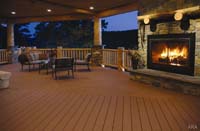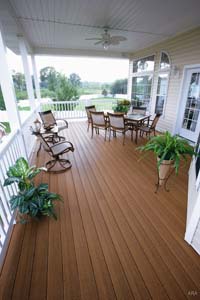|
Adding or Upgrading a Deck is Great Alternative to Vacation Spending
(ARA) - Instead of spending on pricey vacations, more Americans are turning to money-saving alternatives in their own backyards. Upgrading or adding a deck is a great way to take advantage of outdoor living spaces. Homeowners today are viewing their outdoor living spaces as extensions of their home. Among the 40 million homeowners who have an available outdoor living space, less than one-third prep their decks appropriately for the season, according to a Glidden brand survey.
Although it now may seem like a challenging time to invest in your home, enhancing your outdoor living space can be cost-effective. Exterior and replacement projects bring homeowners the best return on investment, according to Remodeling Magazine's annual Cost vs. Value report. "Outdoor living has become an increasingly popular trend over the last few years," says Stephen McNally, vice president of sales and marketing for TAMKO Building Products, Inc. "When selecting your future decking material, research all of your options to ensure you're purchasing material that best meets your needs." When making a decision on your available decking options, you may want to consider the three common types of decking material:
Composite decking is made from a blend of woods and recycled plastic, vinyl or acrylic materials that prolong the life of the deck. Although the initial price of composite decking may be higher compared to other types of wood, the expected lifespan can save money in the long run. Many homeowners are attracted to composite decking because it provides the appearance of real wood, requires little maintenance and typically comes with a longer warranty period. For example, TAMKO's EverGrain is backed by a 25-year limited warranty. "Composite decking requires no painting or staining which allows homeowners to spend more time enjoying their decks rather than working to maintain them," says McNally. Pressure-treated Pressure-treated wood contains preservatives that provide protection against termites, insects and fungal decay. The wood product is placed into a depressurized cylinder. The cylinder is filled with preservatives under high pressure that forces them deeply into the wood. When the process ends, the cylinder is drained and the remaining preservative is reused. Applying preservatives is an attempt to slow drying which means less shrinkage occurs and the surface of the wood remains smoother longer. Although pressure-treated wood is usually found at relatively low cost, it is at high risk for moisture damage. In order to protect a pressure-treated deck against weather and premature aging, the wood requires regular power washing and yearly application of stain and sealer. Cedar is another commonly used decking material because it is attractive, easy to work with and is naturally rot and insect-resistant. Cedar wood decking material has less than half the swelling and shrinking tendencies of other domestic softwoods. If cedar wood goes untreated, over time it will lose its natural golden hue and may turn a silver grey color. The average lifespan of cedar is roughly 10 years and, in order to double the lifespan, regular applications of staining and waterproofing are highly recommended. When you're ready to begin creating or improving your outdoor living space, research your options. Be sure you're picking the best available material to ensure your deck will last you many more summer months to come. Courtesy of ARA content For more information on decking upgrades, please read these articles:
|
|
||||||||||||
|
||||||||||||||
|
|
||||||||||||||



 If
you're planning on using your outdoor living space this season, you may want to
consider improving or upgrading your current deck.
If
you're planning on using your outdoor living space this season, you may want to
consider improving or upgrading your current deck.  Composite Representing 40 to 60 percent of new decks, composite decking is
the latest trend in outdoor living spaces.
Composite Representing 40 to 60 percent of new decks, composite decking is
the latest trend in outdoor living spaces.